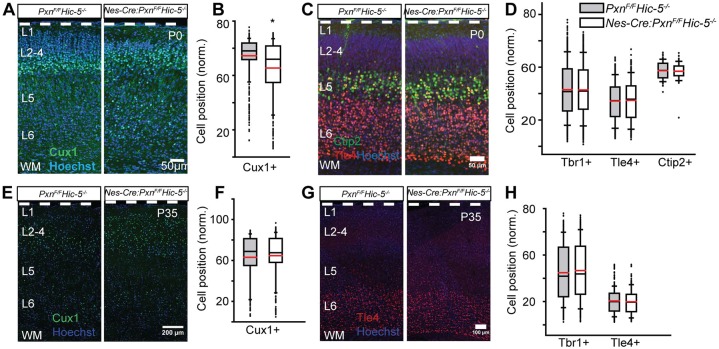Fig. 4.
Combined Hic-5 deficiency with paxillin deficiency (dKO) produces an upper layer neuronal positioning defect similar to that observed with paxillin deficiency alone. (A-D) Neuronal position analysis of P0 cortex. (A) Representative images of P0 littermate control and dKO immunostained for Cux1 (green). More Cux1+ neurons were found in ectopic deep positions in the dKO cortex compared with littermate controls. (B) Box-and-whisker plot distribution of Cux1+ neurons showing a broad distribution of Cux1+ neurons in the dKO cortex. Mean position of Cux1+ neurons is significantly deeper in the dKO cortex (n=5 per group). (C) Representative images of Tle4+ (red) and Ctip2 (green) neurons at P0. (D) Distribution of Tbr1+ (n=5), Tle4+ (n=4) and Ctip2+ (n=3) neurons. No difference in the mean positions of the markers was found between genotypes. (E-H) Neuronal position analysis of P35 cortex. (E) Representative images of P35 littermate control and dKO immunostained for Cux1 (green). (F) Distribution of Cux1+ neurons. There was no difference in the mean position of Cux1+ neurons between genotypes (n=6). (G) Representative image of Tle4+ (red) neurons at P35. (H) Distribution of Tbr1+ (n=6) and Tle4+ (n=4) neurons. There was no difference in the mean position of either Tbr1+ or Tle4+ neurons between genotypes. Data were analyzed using unpaired Student's t-test. *P<0.05. Scale bars: 50 µm in A,C; 200 μm in E; 100 μm in G.

